Agencies are a crucial component of many brands’ marketing strategies–and for good reason. A great agency partner can drive major growth for businesses by helping in-house teams build powerful strategies, deliver innovative ideas and creative, drive incremental impact, and more.
But establishing and maintaining an effective agency/brand relationship can be easier said than done: factors like market fluctuations, shifting needs and expectations, and changing consumer behaviors can have a significant impact on the effectiveness of the overall partnership.
A strong collaboration will position your business to win in a fast-changing media and marketing ecosystem–so how can your brand improve your agency dynamics to get the most out of your partnerships?
Wpromote and Ascend2 joined forces to dig into the details by surveying 500+ brands and agencies on what’s working for them and how those partnerships are evolving to help you better understand how to get what you need from the marketing, media, data, and creative experts you’re working with on the agency side.
The impact of brand/agency alignment
Alignment between businesses and agencies packs a punch when it comes to business outcomes. Companies with positive agency relationships reap benefits like stronger revenue growth, higher return on investment (ROI), better brand performance, and more strategic allocation of marketing budgets.
With all those upsides on the table, many brands aren’t fully satisfied with their agencies. We all remember how hard a group project can be an agency/brand relationship is no different. A working relationship that close and collaborative can be challenging by nature.
Many of these issues arise from poor communication and a lack of agreement between agency and brand on shared goals and how success is defined. There’s a significant disconnect between brands’ evaluation of partnerships and agency assessments of their own services: agency confidence tends to far outpace brand satisfaction across all categories, which we break down in detail in the full survey report.
That’s especially clear when it comes to the overall delivery of services: 76% of agencies report they are very confident, while only 39% of brands report that they are very satisfied with that delivery.
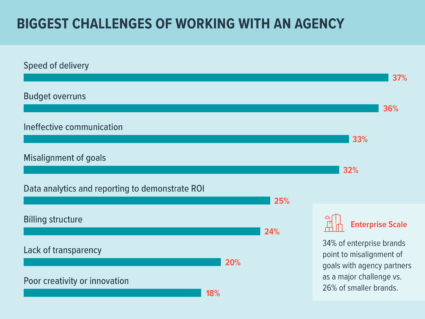
Beyond strategic needs, the partnership’s logistics must also run smoothly. The top two challenges for brands are execution-focused: the speed of agency delivery and budget overruns. Those are closely followed by ineffective communication and goal misalignment, which represent persistent challenges with the partnership overall.
These problems can also be exacerbated by working with multiple agencies (which many brands do). Brands working with two or more agencies are significantly more likely to report challenges around goal alignment, speed of delivery, demonstrating ROI, and billing structure.
Key challenges for agency/brand partnerships
To help your brand improve your agency relationships and get better results, we’re double-clicking into these key challenges–and exploring some solutions to help you get back on track.
Speed of Delivery
In today’s tough marketing climate, brands are increasingly challenged to do more with less, even as platforms, audiences, and budgets are constantly changing.
Agency partners need to deliver results rapidly, producing great work despite shortened project timelines and quick turnarounds. That can be a major source of tension, since agencies sometimes struggle to meet those expectations, while businesses find quick work essential in a fast-paced media ecosystem subject to constant evolution.
That’s why so many brands point to speed of delivery as the biggest challenge of working with an agency, and that’s not likely to change for most agency/client partnerships any time soon. Only 34% of brands report high satisfaction with the speed of project delivery, but 65% of agencies are confident in their speed of delivery.
That disparity might tell us why only 36% are prioritizing it as an area of improvement in the coming year. If your brand isn’t satisfied with how fast your agency is responding to requests, it’s a good idea to bring up your expectations to your partners–otherwise, they might not be aware of the issue. And if they can’t make those adjustments, it may be time to look for a different partner.
Budget Adjustments
With macro-economic factors like inflation in play and new twists in the industry like the deprecation of third-party cookies or the (unlikely) potential of a TikTok ban on the horizon, brands need to keep their budgets agile to keep up with a fast-changing world.
The good news is that agencies are actually more flexible in areas like adjusting billing and contracts than brands might expect. Just 44% of brands believe agencies are willing to adjust billing and contracts based on changing needs, while 55% of agencies are open to those adjustments.
To tap into that flexibility, many brands choose to work with agencies on a project-based billing structure instead of a monthly retainer. That can give you the freedom to deploy agency partners to focus on specific projects based on your current needs, rather than committing to a strict budget that might not fit changing plans and expectations.
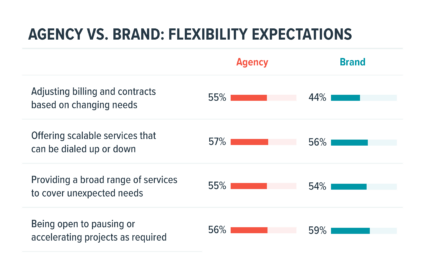
Communication and Transparency
Communication is another major source of conflict between agencies and brands.
Part of the issue is the frequency of communication: only 44% of brands report being very satisfied with the frequency of communication and check-ins from their agency partners vs. 68% of agencies.
Making matters worse, brands and agencies seem to disagree on how often they actually talk. Over three-quarters (78%) of agencies report communicating with their clients on a daily or weekly basis, but brands report less frequent communication, with 40% saying communication is bi-weekly, monthly, or on an as-needed basis. Brands and agencies need to get on the same page by setting up a clear, agreed-upon communication schedule in advance, so no one is left hanging by a skipped meeting or a missed message.
Of course, communication is more than just the frequency of meetings or emails–it’s also about transparency and clarity. When agencies and brands are honest with each other, that fosters an environment of trust, collaboration, and optimization.
The right level of transparency correlates with stronger overall happiness with the partnership. Brands that are highly satisfied with the level of transparency from agencies are 3x more likely to report that they are highly satisfied with the overall partnership, at a rate of 65% vs. 21%.
Unfortunately, that’s not always happening: just 35% of brands report being very satisfied with agency transparency, while nearly two-thirds (63%) of agencies feel highly confident about their level of transparency with clients.
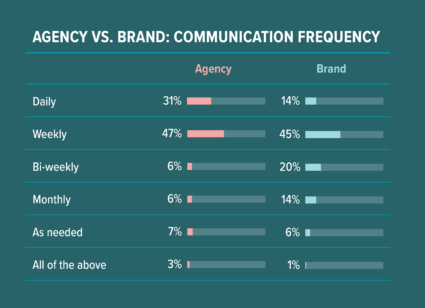
Evaluating your agency relationships
As great as agencies are for brands looking to expand their marketing, it’s easy to run into trouble if you’re not managing your relationships the right way. It’s crucial to review the most important aspects of your agency partnerships on a regular basis to make sure everyone is on the same page, especially when it comes to common issues like communication, budget flexibility, speed of delivery, and more.
You should also consider if the agency or agencies you’re working with meet your brand’s specific needs. Different agencies offer different capabilities, ways of working, and value for brands. You don’t have to settle for a partner that doesn’t work for you.
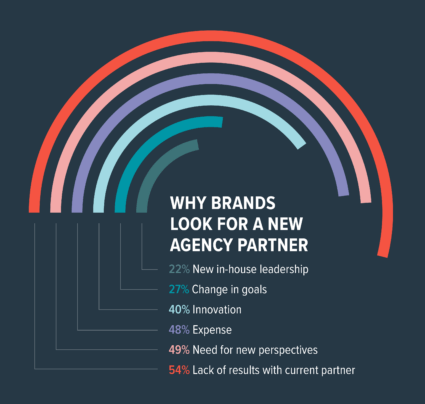
Every brand has different standards when it comes to considering a change, but most brands say they would likely start looking for a new agency partner due to a lack of results. 49% would consider a new partner because they need new perspectives or they’re looking to cut costs.


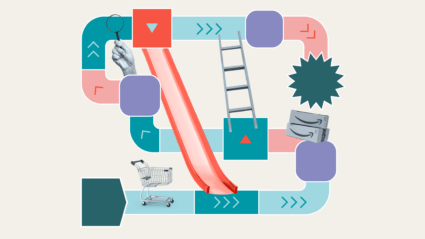




Responses